[178] in France. Buffon was compelled to retract hypotheses which he put forward about the formation of the earth in his Natural History (1749), and to state that he believed implicitly in the Bible account of Creation.
At the beginning of the nineteenth century Laplace worked out the mechanics of the universe, on the nebular hypothesis. His results dispensed, as he said to Napoleon, with the hypothesis of God, and were duly denounced. His theory involved a long physical process before the earth and solar system came to be formed; but this was not fatal, for a little ingenuity might preserve the credit of the first chapter of Genesis. Geology was to prove a more formidable enemy to the Biblical story of the Creation and the Deluge. The theory of a French naturalist (Cuvier) that the earth had repeatedly experienced catastrophes, each of which necessitated a new creative act, helped for a time to save the belief in divine intervention, and Lyell, in his Principles of Geology (1830), while he undermined the assumption of catastrophes, by showing that the earth’s history could be explained by the ordinary processes which we still see in operation, yet held fast to successive acts of creation. It was not till 1863 that he presented fully, in his Antiquity of Man, the
[179] evidence which showed that the human race had inhabited the earth for a far longer period than could be reconciled with the record of Scripture. That record might be adapted to the results of science in regard not only to the earth itself but also to the plants and lower animals, by explaining the word “day” in the Jewish story of creation to signify some long period of time. But this way out was impossible in the case of the creation of man, for the sacred chronology is quite definite. An English divine of the seventeenth century ingeniously calculated that man was created by the Trinity on October 23, B.C. 4004, at 9 o’clock in the morning, and no reckoning of the Bible dates could put the event much further back. Other evidence reinforced the conclusions from geology, but geology alone was sufficient to damage irretrievably the historical truth of the Jewish legend of Creation. The only means of rescuing it was to suppose that God had created misleading evidence for the express purpose of deceiving man.
Geology shook the infallibility of the Bible, but left the creation of some prehistoric Adam and Eve a still admissible hypothesis. Here however zoology stepped in, and pronounced upon the origin of man. It was an old conjecture that the higher forms of life, including




